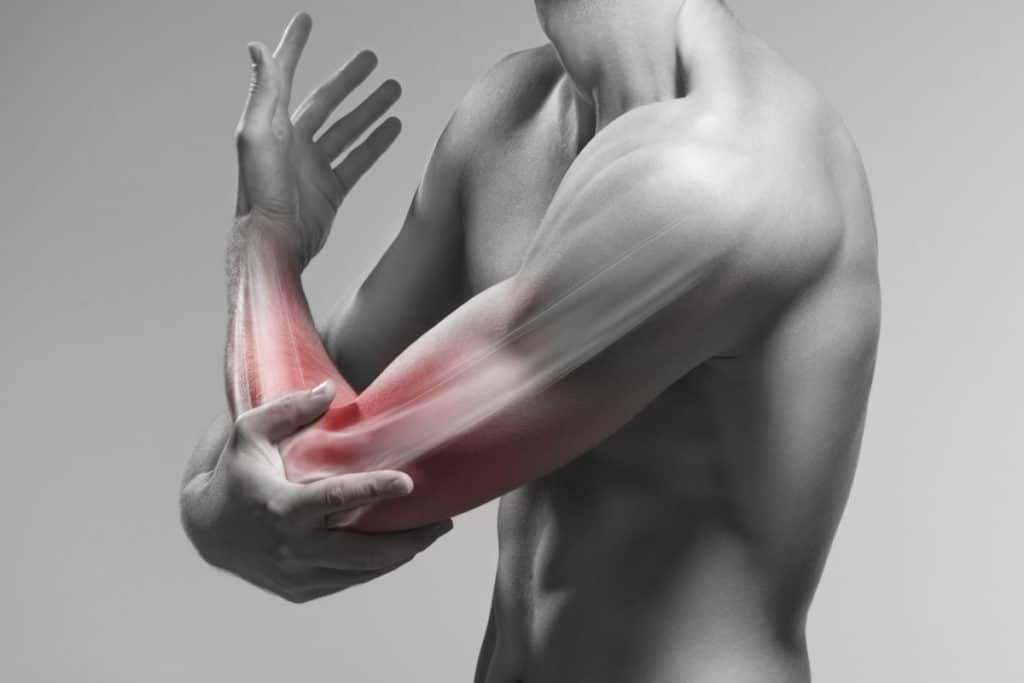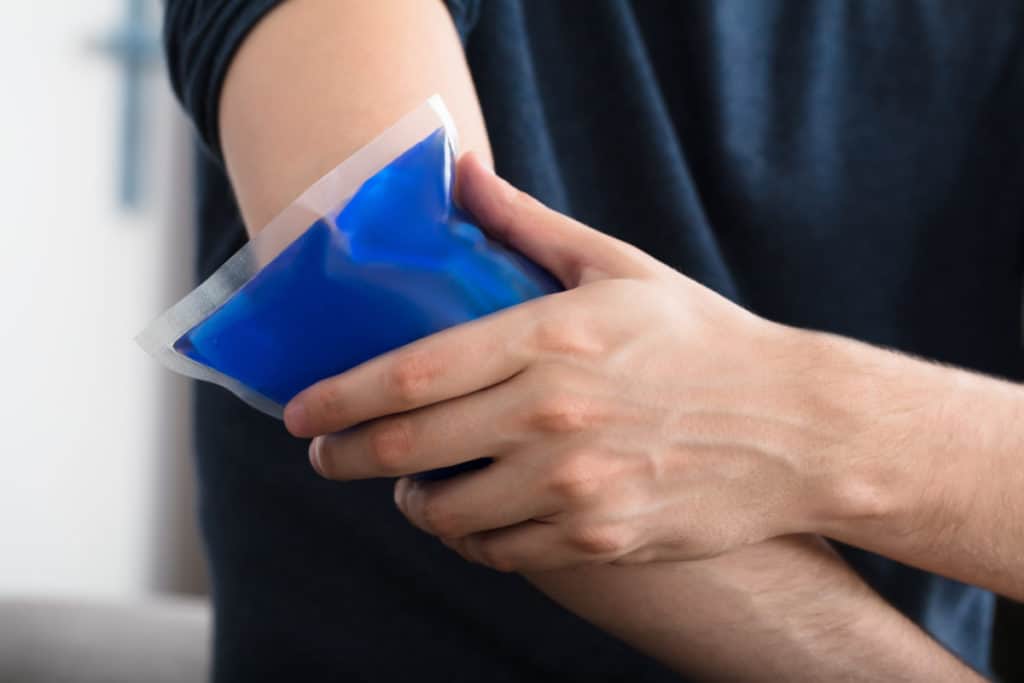
Paddler’s elbow or Tennis elbow as some people call it is known as lateral epicondylitis. The condition occurs when a person over stretches the tendons of the forearm. People can usually treat their tennis elbow in the comfort of their homes using over the counter medications. Besides medication, you can do specific exercises to relieve pain and prevent recurrences.
I have provided eight tips on how you can sleep with this condition, three exercises that can help you prevent paddler’s elbow and when you should see a doctor. Before trying these exercises, wait for any swelling to go down. It is a good idea first to consult an occupational therapist, a doctor or physiotherapist.
Eight tips for sleeping with paddler’s elbow
1. Positioning yourself
The way you sleep with a sprained elbow is very important to avoid more pain and increase the odds of sleeping through the night.
If you have one side of your bed against a wall, then you should support the pillow vertically against the wall with half on the wall and the other half on the bed. This will make it easier to slide into a flat position after placing your arm. After that, sit with your back on the pillow and place a second pillow next to you. This is meant to allow your arm to rest and keep it high once you are lying down.
Once you are seated then place your arm on the pillow, slowly slide your body down until you are lying on your back. Keep your arm resting on the adjacent pillow high enough to be above the heart.
If you have a sling, the arrow will naturally want to retract when you get to bed. As such, you need to tighten the muscles to keep them in place. It can be very painful. To prevent this from happening, slide a little to the other side of the wound and place a pillow vertically along the back of your shoulder to the bottom of the lever. When you roll on the pillow, your elbow will be raised to a more neutral and comfortable position for sleeping.
2. Sleep Where you Need to
At the start of an injury, it may be easier to sleep on a sofa chair with armrests. This can help put the arm in a more comfortable position to avoid pain and swelling. You’re arm should be suspended normally, rather than placing it in a critical state overnight that can lead to stiffness. The body naturally wants to stay flat, so wrap some pillows around you for comfort and avoid rolling in an awkward position.
3. Use lots of pillows
Surround yourself with pillows for more comfort. Place a large pillow under your arms, not just the injured one. This keeps the body in a neutral position. Relaxation can also be increased a little by your arms. While you’re on your back, place a pillow under your knees to help align the spine and prevent back pain in the morning. It also stabilizes the body and prevents you from turning. Use a good, high-quality pillow that supports the head and neck. You can also invest in a special pillow designed to keep your body height.
For the lateral sleeping position, it is important to use lots of pillows to keep you in place. If your injury is on your right arm, lie on your left side, then place two or three pillows on your stomach. This prevents the body from rolling over the stomach and causing more damage to the elbow. Do the opposite if your cords are on your left arm. You can also fold a pillow to get more height so that it is flat with your injured arm.
4. Dress Comfortable
Before going to bed, you want to make sleeping as easy as possible. One way to do this is to wear comfortable clothing. Wear light, breathable clothing to prevent sweating and itching. Mold can increase body temperature, so wearing light clothing should help keep the air fresh. The body should be at a neutral temperature overnight to stay relaxed and promote good blood circulation. Some clothing ideas include:
- Cotton, or linen clothing
- Good and light pajamas keep the body cool at night
- Light athletic pants and a long-sleeved shirt in winter
5. Take any Prescribed Pain Medication
Pain relievers can help relieve some pain before bedtime. Your doctor may recommend over-the-counter medications like acetaminophen (Tylenol). Avoid anti-inflammatory drugs like aspirin and ibuprofen. It can slow down the healing process as it prevents the production of chemicals created in the body specifically for healing fractures. When taking the medication, carefully follow the directions on the label and follow only what is required.
6. Icing the Elbow

Inhibiting injuries can help relieve pain and swelling and help get a good night’s sleep. You can use a bag of frozen peas, an ice pack, or an ice cube with a cloth. Apply ice to the affected area for 20 minutes every 4 hours for the first 2 days. Avoid direct application to the skin as this can damage the skin. If you do apply it directly to you’re skin then apply it for a short time. Wrap it with a cloth, paper towel or shirt. Also, try a cold and hot treat with the Elbow Support wrapping gel pack. It provides pressure with hot and cold treatment to relieve the elbow.
7. Exercising
A simple exercise can help you prevent stiffness and swelling. Even the simple act of moving you’re body and doing a light stretch can help you fall asleep faster but also speed up the healing process. Your therapist can provide instructions on how to properly exercise you’re arm when you’re by yourself. Ultimately, you want the elbow to rest as much as possible until the swelling subsides, but after a while, simple exercises may be recommended.
Simple exercises promote good blood circulation, strengthen muscles, and speed up the recovery process. It also prevents you’re elbow from becoming rigid. Exercise can help you relax before bed and make it easier to sleep. If you are on ropes or a throw, you can still stay active during recovery. Get into a routine by doing these exercises throughout the day. Make sure to keep it light as you don’t want more elbow damage. Also go out in the sun. It is healthy for your mind and body and will help you improve your sleep at night.
8. Relax with breathing techniques
Sleep can be tough when you are suffering from a sprained elbow. The pain is a distraction that occupies your mind instead of letting you fall a sleep. One way to get you’re mind off the pain is to focus on your breathing. This method is called the 4-7-8. Breathe in slowly through your nose for four seconds, hold it for seven seconds before exhaling, and then breathe in for eight seconds. Repeat and focus on each breath. In the end, your mind will stop focusing on your elbow and you will fall asleep. At first, it can be difficult because your lungs are not used to it. Over time, it will be easier to do and you will find that not only does it help you fall asleep faster, but it can also improve your overall health.
Three ways to avoid getting paddler’s elbow
1. Stay in the scope of your paddler’s box
The paddler’s box describes the metaphorical “box” created between your arms, your racket, and your chest when you are on strike. The rower moves with you while your torso is spinning, and it is usually important to stay inside the rower during rowing to avoid compromising positions and stress. The more you avoid muscle fatigue, the less tendonitis you will have.
2.Grip your paddle lightly
The rapid removal of the paddle puts a strain on your muscles on the forearm, making you more likely to overuse. A light fist will reduce the risk of acute injury, as well as tendonitis.
3.Communicate with your torso
When rowing, try to avoid stretching the full attachment. Instead, focus on communicating with your torso instead of your arms to begin every paddling stroke. This usually means less fatigue during an extended day in the water, helping to prevent overuse.
When you should see a doctor
Most people can treat elbow pain and inflammation with rest and medication outside the body. If the pain is severe or does not go away within two weeks, the person should see a doctor.
Your doctor may prescribe various steroid injections or NSAIDs. Most people only need one injection, although they may need their elbow rest for 2-3 weeks after that. The pain may get worse after the steroid injection, but it should improve within 2 days.
Some people may find that the tennis facility affects their daily activities. In these cases, your doctor may recommend physical or professional therapy. A specialist can provide treatments and exercises to help improve movement and relieve pain.
Your therapist may also recommend a support clip or splint. This can help reduce the pressure on the elbow if repeated movements are necessary for a person’s work.